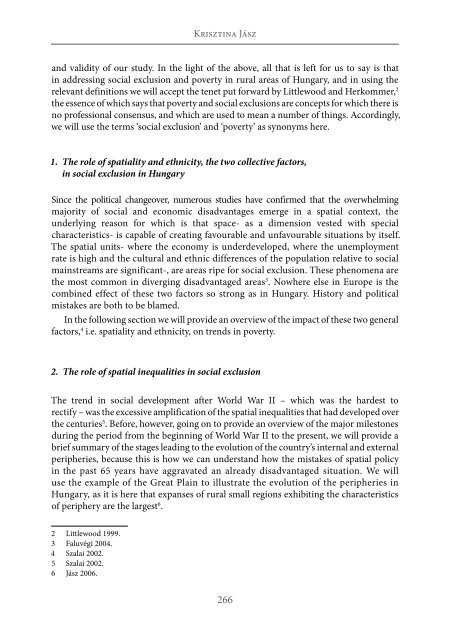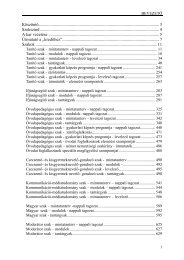- Page 2 and 3:
the consequences of blame avoidance
- Page 4 and 5:
the consequences of blame avoidance
- Page 6 and 7:
the consequences of blame avoidance
- Page 8 and 9:
Preface the consequences of blame a
- Page 10 and 11:
the consequences of blame avoidance
- Page 12 and 13:
Preface the consequences of blame a
- Page 14 and 15:
the consequences of blame avoidance
- Page 16 and 17:
the consequences of blame avoidance
- Page 18 and 19:
the consequences of blame avoidance
- Page 20 and 21:
the consequences of blame avoidance
- Page 22 and 23:
the consequences of blame avoidance
- Page 24 and 25:
the consequences of blame avoidance
- Page 26 and 27:
praxisorientierte aufgaben und proj
- Page 28 and 29:
praxisorientierte aufgaben und proj
- Page 30 and 31:
praxisorientierte aufgaben und proj
- Page 32 and 33:
praxisorientierte aufgaben und proj
- Page 34 and 35:
praxisorientierte aufgaben und proj
- Page 36 and 37:
praxisorientierte aufgaben und proj
- Page 38 and 39:
HOW DO CULTURES COMMUNICATE THEIR V
- Page 40 and 41:
HOW DO CULTURES COMMUNICATE THEIR V
- Page 42 and 43:
HOW DO CULTURES COMMUNICATE THEIR V
- Page 44 and 45:
HOW DO CULTURES COMMUNICATE THEIR V
- Page 46 and 47:
HOW DO CULTURES COMMUNICATE THEIR V
- Page 48 and 49:
HOW DO CULTURES COMMUNICATE THEIR V
- Page 50 and 51:
HOW DO CULTURES COMMUNICATE THEIR V
- Page 52 and 53:
HOW DO CULTURES COMMUNICATE THEIR V
- Page 54 and 55:
HOW DO CULTURES COMMUNICATE THEIR V
- Page 56 and 57:
HOW DO CULTURES COMMUNICATE THEIR V
- Page 58 and 59:
Wine routes in the south transdanub
- Page 60 and 61:
Wine routes in the south transdanub
- Page 62 and 63:
Wine routes in the south transdanub
- Page 64 and 65:
Wine routes in the south transdanub
- Page 66 and 67:
Wine routes in the south transdanub
- Page 68 and 69:
Wine routes in the south transdanub
- Page 70 and 71:
Wine routes in the south transdanub
- Page 72 and 73:
Wine routes in the south transdanub
- Page 74 and 75:
Wine routes in the south transdanub
- Page 76 and 77:
Wine routes in the south transdanub
- Page 78 and 79:
Wine routes in the south transdanub
- Page 80 and 81:
Wine routes in the south transdanub
- Page 82 and 83:
Wine routes in the south transdanub
- Page 84 and 85:
Vermarktung in der gastronomie verm
- Page 86 and 87:
Vermarktung in der gastronomie fach
- Page 88 and 89:
Vermarktung in der gastronomie Wein
- Page 90 and 91:
Vermarktung in der gastronomie sein
- Page 92 and 93:
Vermarktung in der gastronomie ●
- Page 94 and 95:
Vermarktung in der gastronomie Mark
- Page 96 and 97:
Measurement problems of the perform
- Page 98 and 99:
Measurement problems of the perform
- Page 100 and 101:
Measurement problems of the perform
- Page 102 and 103:
Measurement problems of the perform
- Page 104 and 105:
Measurement problems of the perform
- Page 106 and 107:
Measurement problems of the perform
- Page 108 and 109:
Measurement problems of the perform
- Page 110 and 111:
Measurement problems of the perform
- Page 112 and 113:
Measurement problems of the perform
- Page 114 and 115:
the choice of gen y: live to learn
- Page 116 and 117:
the choice of gen y: live to learn
- Page 118 and 119:
the choice of gen y: live to learn
- Page 120 and 121:
Internet References (Internet links
- Page 122 and 123:
text based cognitive linguistic res
- Page 124 and 125:
text based cognitive linguistic res
- Page 126 and 127:
text based cognitive linguistic res
- Page 128 and 129:
text based cognitive linguistic res
- Page 130 and 131:
text based cognitive linguistic res
- Page 132 and 133:
text based cognitive linguistic res
- Page 134 and 135:
interpretationsmöglichkeiten eines
- Page 136 and 137:
interpretationsmöglichkeiten eines
- Page 138 and 139:
interpretationsmöglichkeiten eines
- Page 140 and 141:
interpretationsmöglichkeiten eines
- Page 142 and 143:
interpretationsmöglichkeiten eines
- Page 144 and 145:
eligious and sacral communities in
- Page 146 and 147:
eligious and sacral communities in
- Page 148 and 149:
eligious and sacral communities in
- Page 150 and 151:
References religious and sacral com
- Page 152 and 153:
eligious and sacral communities in
- Page 154 and 155:
eligious and sacral communities in
- Page 156 and 157:
interpretationsmöglichkeiten eines
- Page 158 and 159:
eligious and sacral communities in
- Page 160 and 161:
developing personal and social comp
- Page 162 and 163:
developing personal and social comp
- Page 164 and 165:
developing personal and social comp
- Page 166 and 167:
psycholinguistische Aspekte des kin
- Page 168 and 169:
psycholinguistische Aspekte des kin
- Page 170 and 171:
psycholinguistische Aspekte des kin
- Page 172 and 173:
psycholinguistische Aspekte des kin
- Page 174 and 175:
psycholinguistische Aspekte des kin
- Page 176 and 177:
psycholinguistische Aspekte des kin
- Page 178 and 179:
psycholinguistische Aspekte des kin
- Page 180 and 181:
psycholinguistische Aspekte des kin
- Page 182 and 183:
das erbe der deutschen und ungarisc
- Page 184 and 185:
das erbe der deutschen und ungarisc
- Page 186 and 187:
das erbe der deutschen und ungarisc
- Page 188 and 189:
das erbe der deutschen und ungarisc
- Page 190 and 191:
das erbe der deutschen und ungarisc
- Page 192 and 193:
das erbe der deutschen und ungarisc
- Page 194 and 195:
das erbe der deutschen und ungarisc
- Page 196 and 197:
introduction to the history of adop
- Page 198 and 199:
introduction to the history of adop
- Page 200 and 201:
introduction to the history of adop
- Page 202 and 203:
introduction to the history of adop
- Page 204 and 205:
introduction to the history of adop
- Page 206 and 207:
introduction to the history of adop
- Page 208 and 209:
introduction to the history of adop
- Page 210 and 211:
introduction to the history of adop
- Page 212 and 213:
introduction to the history of adop
- Page 214 and 215: introduction to the history of adop
- Page 216 and 217: THE RELATIONSHIPS BETWEEN THE SPECI
- Page 218 and 219: THE RELATIONSHIPS BETWEEN THE SPECI
- Page 220 and 221: THE RELATIONSHIPS BETWEEN THE SPECI
- Page 222 and 223: THE RELATIONSHIPS BETWEEN THE SPECI
- Page 224 and 225: THE RELATIONSHIPS BETWEEN THE SPECI
- Page 226 and 227: THE RELATIONSHIPS BETWEEN THE SPECI
- Page 228 and 229: andor csizmadia, the social-politic
- Page 230 and 231: andor csizmadia, the social-politic
- Page 232 and 233: andor csizmadia, the social-politic
- Page 234 and 235: andor csizmadia, the social-politic
- Page 236 and 237: andor csizmadia, the social-politic
- Page 238 and 239: andor csizmadia, the social-politic
- Page 240 and 241: poverty certificate, both an advant
- Page 242 and 243: poverty certificate, both an advant
- Page 244 and 245: poverty certificate, both an advant
- Page 246 and 247: poverty certificate, both an advant
- Page 248 and 249: poverty certificate, both an advant
- Page 250 and 251: Bibliography: poverty certificate,
- Page 252 and 253: analysis of the social service-plan
- Page 254 and 255: analysis of the social service-plan
- Page 256 and 257: analysis of the social service-plan
- Page 258 and 259: analysis of the social service-plan
- Page 260 and 261: analysis of the social service-plan
- Page 262 and 263: analysis of the social service-plan
- Page 266 and 267: poverty in the rural hungary A key
- Page 268 and 269: poverty in the rural hungary the fi
- Page 270 and 271: poverty in the rural hungary the Ro
- Page 272 and 273: poverty in the rural hungary 4. A f
- Page 274 and 275: poverty in the rural hungary differ




